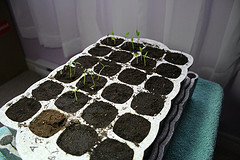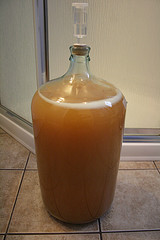Food Education Action St. John's (FEASt) presents an afternoon of gardening and local food activities to get people in the St. John's region excited and prepared for the growing season. Whether you're thinking of growing your first herb plant in a container or you're a seasoned gardener with a yard of veggies planned, there's going to be something at FEASt Fest for you!
Intro To Composting
When you're trying to garden organically, it can get kind of expensive buying all the compost you'll need. You're much better off making your own - you can divert a surprising amount from the landfill (which makes taking the garbage out a lot easier), and you're turning waste in to gold! It's not terribly difficult to get started, since we're working with what nature does on its own!
 If you've got a yard, then you should definitely look at an outdoor compost pile. Either a premade composter, like the one in the photo, or something you build yourself is fine. You can build one for yourself for very little money, if you're willing to do a bit of salvage work. Using untreated wooden pallets is an excellent way to get a composter put together for practically nothing - my father has been using his for over 10 years, and while he's made a few modifications along the way, the basic structure is still just 3 pallets. Just google "Composter Pallets", and you'll come up with plenty of designs. Alternatively, the MMSB will be working with municipal governments across Newfoundland and Labrador to partially subsidize the sale of composters. If you're interested, you can read more here, or contact your town office.
If you've got a yard, then you should definitely look at an outdoor compost pile. Either a premade composter, like the one in the photo, or something you build yourself is fine. You can build one for yourself for very little money, if you're willing to do a bit of salvage work. Using untreated wooden pallets is an excellent way to get a composter put together for practically nothing - my father has been using his for over 10 years, and while he's made a few modifications along the way, the basic structure is still just 3 pallets. Just google "Composter Pallets", and you'll come up with plenty of designs. Alternatively, the MMSB will be working with municipal governments across Newfoundland and Labrador to partially subsidize the sale of composters. If you're interested, you can read more here, or contact your town office.
Once you've got your bin ready, what do you put in it? After all, you don't want to end up with unwanted visitors to your compost pile! Here's a list of some things that are safe to put in your bin:
Most of what is listed above is considered "greens", meaning that they're excellent sources of nitrogen. However, to have an effective composter, you'll want to balance the "greens" with "browns", or sources of carbon. Dead leaves can be good, but since most of the year they're not available, I like using shredded newspapers and torn-up egg cartons (as long as they're those grey ones, since they're made with a really low-grade paper).
Things you'll want to avoid include meat, dairy, and oils (used or not). These tend to attract unwanted pests like rats, which you really don't want to deal with - trust me on this. That being said, even a well-managed compost pile can occasionally attract the attention of wildlife. If this happens, you will need to take steps to keep them out. When using the black plastic ones, this can be a bit easier, since they're enclosed. I recommend getting some wire lath (the stuff they used to use on plaster walls), and attaching it wherever they're getting in. If they're digging their way in, you may need to dig a shallow trench around the immediate perimeter of the composter, and bury it about 6-8 inches deep. With more open designs, you may need to attach wire lath on the outside, as well as burying it around the perimeter, to prevent climbing. Please note, wire lath is VERY sharp, so be really careful when using it, and if you've got small children or animals, you may want to investigate other options.
Another method of composting that can work very well for those with limited or no outdoor space is vermicomposting. Essentially, you are adopting a colony of worms that eat your vegetable waste. Most of what I listed above as ok/not ok applies, though I would steer clear of citrus peels (worms really seem to dislike them), and make sure that any egg shells are VERY well crushed. You can often buy kits from companies that sell worms, which is very handy. I'll get more in-depth on vermicomposting in another post, but keep in mind - even if you have plenty of yard space, your worms can help with any overflow from your kitchen, especially in the cold months!
Vegetable Gardening Workshop in Corner Brook
How Are Things Growing - April Edition
Yes, there are actually things growing already! Here are a few things I've got on the go so far:
 Peppers: The first sprouts came up just as April started, and I'm seeing lots of growth in some of the varieties already. Not all of the types have sprouted yet, but peppers can be a bit slow. In fact, I was surprised to see any this soon! I've got 13 varieties planted, with a good mix of sweet and hot peppers. Right now, the sweet peppers are in the lead, so they'll probably be ready for transplant first.
Peppers: The first sprouts came up just as April started, and I'm seeing lots of growth in some of the varieties already. Not all of the types have sprouted yet, but peppers can be a bit slow. In fact, I was surprised to see any this soon! I've got 13 varieties planted, with a good mix of sweet and hot peppers. Right now, the sweet peppers are in the lead, so they'll probably be ready for transplant first.
 Salad Greens: These only took a few days to start sprouting, and hopefully I'll be harvesting them for salads in a few more weeks. I used those clear containers that berries come in (yes, occasionally non-local berries end up in the house), and packed them with seed starter mix. Since I'm not worried about transplanting, their relatively shallow depth isn't a problem.
Salad Greens: These only took a few days to start sprouting, and hopefully I'll be harvesting them for salads in a few more weeks. I used those clear containers that berries come in (yes, occasionally non-local berries end up in the house), and packed them with seed starter mix. Since I'm not worried about transplanting, their relatively shallow depth isn't a problem.
 Hard Cider:Ok, not really a planting, but it does involve live organisms (yeast). I started this batch about a week ago, using apple juice, a can of frozen apple juice concentrate, and a packet of Champagne yeast. This is my second batch, and I'm hoping it'll be even better than my first (which was actually pretty good).
Hard Cider:Ok, not really a planting, but it does involve live organisms (yeast). I started this batch about a week ago, using apple juice, a can of frozen apple juice concentrate, and a packet of Champagne yeast. This is my second batch, and I'm hoping it'll be even better than my first (which was actually pretty good).
Have you got any cool spring projects on the go? Post about them in the comments!






